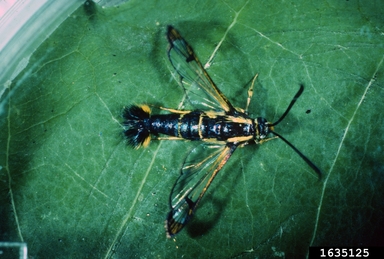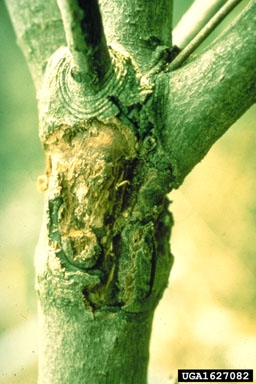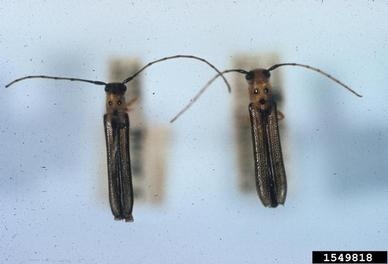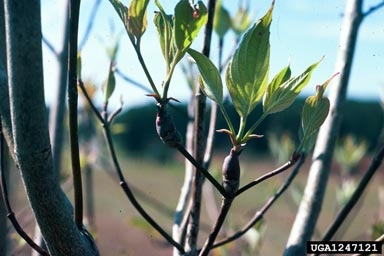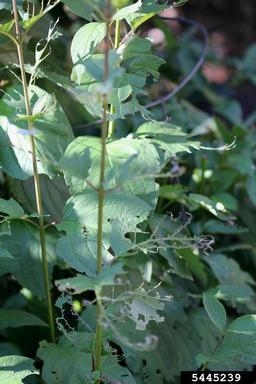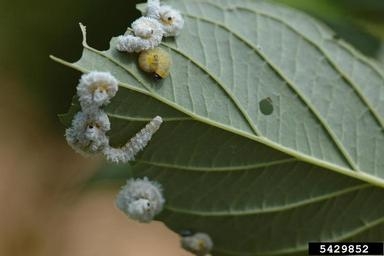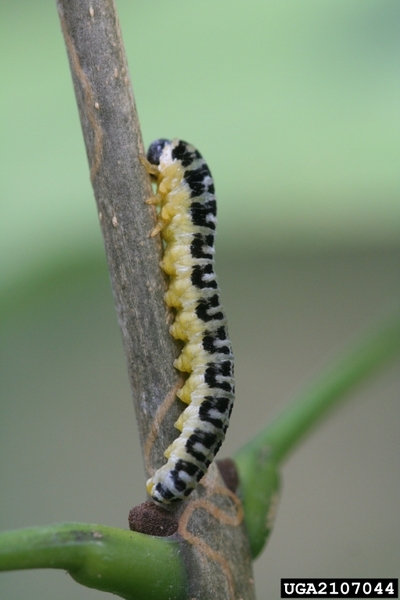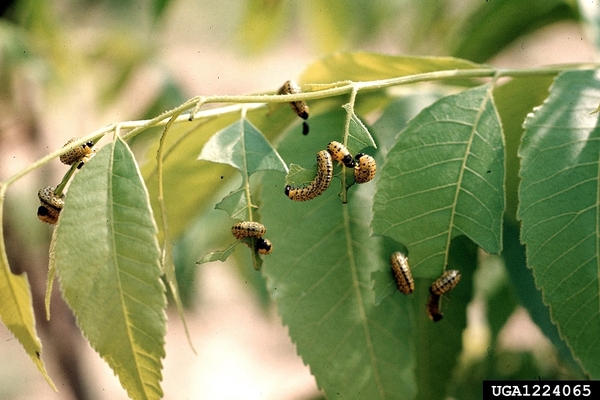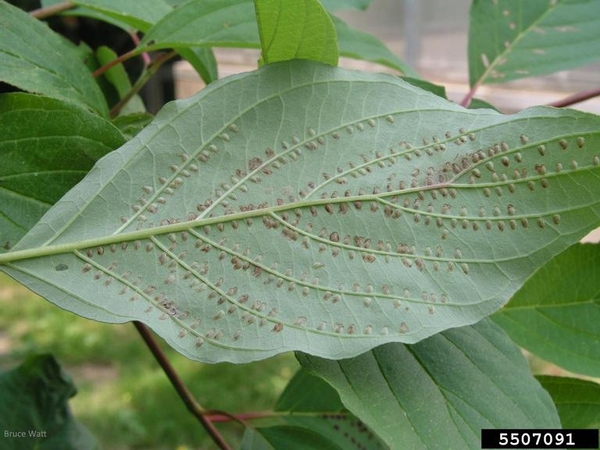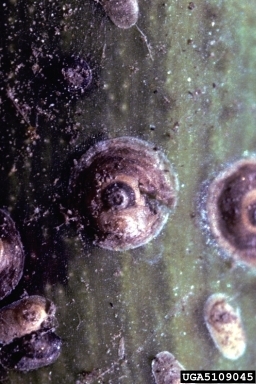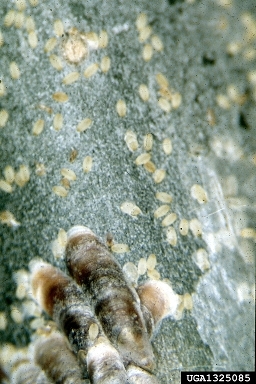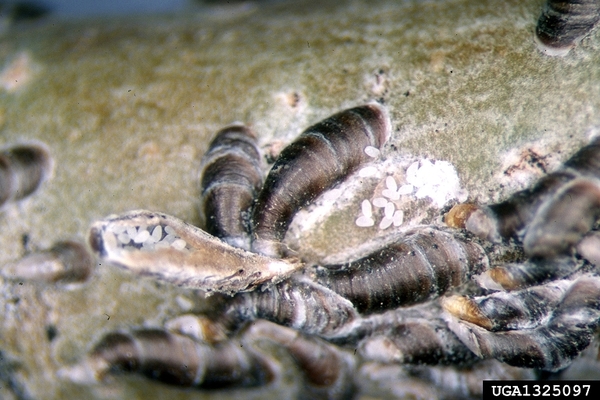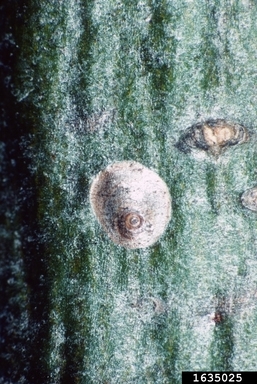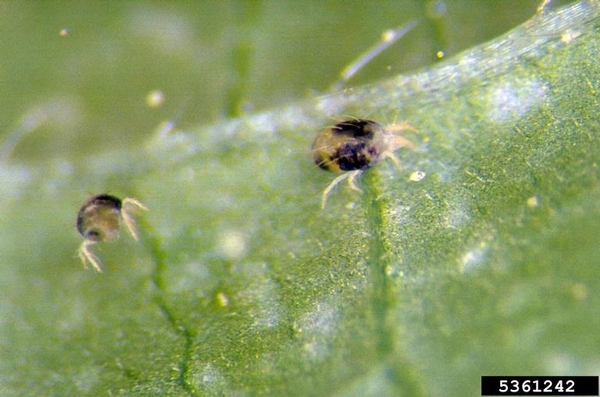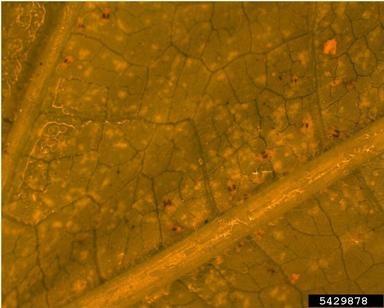Introduction
Dogwoods are beloved trees in North Carolina. The showy white flowers of flowering dogwood (Benthamidia florida) are a welcome sign of spring and became the state flower in 1941. Many choose to plant dogwoods in their landscapes, as well, so recognizing dogwood pests and having accessible management resources are important in managing this beautiful landscape or forest tree.
Dogwood Borer
The dogwood borer (DWB; Synanthedon scitula) is a wood-boring moth that infests dogwood, apple, pecan, hickory, elm, willow, and other deciduous trees. In late spring, adult DWB lay eggs on the bark, often near or on burr knots, root initials that develop above ground creating tumor-like growths. Larvae require a wound or opening to bore into the burr knot or under the bark. They feed within the tree for about a year then pupate the following spring. Reddish-brown frass may accumulate around infested burr knots or at the trunk base and is often the first observed sign that DWB is present. Generally, feeding on burr knots does not harm the tree, but feeding beneath the bark may cause girdling of vascular tissues. Several consecutive years of infestation can stunt growth and cause decline or death. Management includes DWB monitoring traps and trunk-applied insecticides. More information about the dogwood borer is available from NC State Extension.
Dogwood Twig Borer
The dogwood twig borer (Oberea tripunctata) is a longhorned beetle that primarily infests flowering dogwood, but also infests elms, viburnums, azaleas, and many fruit trees in North Carolina. Adult beetles fly to new growth in late spring and chew two rows of holes between which they eggs. When the eggs hatch, immature grubs begin feeding within stems, boring downward and girdling twigs. During this process, grubs push waste products out of holes in the stems. Infestations by this insect are sporadic, so treatment is not needed annually. Infested stems can be pruned off and insecticides can be sprayed on a tree to prevent egg-laying. More information about the dogwood twig borer is available from NC State Extension.
Dogwood Club-Gall Midge
The dogwood club-gall midge (Resseliella clavula) is a small fly that causes swollen tissues (called galls) in stems or leaf stalks (called petioles) of dogwood trees. In early spring, females lay eggs in developing buds. When the eggs hatch, the larvae feed within the bud, secreting saliva that causes a swollen club- or spindle-shaped gall to form. The larvae develop inside the gall until ready to pupate, at which time they chew an exit hole in the side of the gall and drop to the ground where they overwinter as pupae. Though damage is often not serious, large infestations can cause twig and bud dieback. Pruning affected limbs can help mitigate damage. More information about the dogwood club-gall midge is available from NC State Extension.
Dogwood Sawfly
The dogwood sawfly (Macremphytus tarsatus) is a wasp that feeds on a variety of dogwood species. Between May and July, the adult wasps emerge and deposit up to 100 eggs into leaf tissue, resulting in small brown bumps to form in rows where each egg was laid. The larvae look and feed quite differently between larval stages. Young larvae are covered in a white and waxy covering and skeletonize leaves. Older larvae are yellow and black and consume the entire leaf except the midrib. When mature, they bore into soft or decaying wood to form pupal cells; sometimes they may even bore into outdoor furniture. The tree is not typically damaged by infestations of dogwood sawfly, but horticultural oils and soaps can be effective in controlling their numbers on high-value plants. More information about the dogwood sawfly can be found from NC State Extension.
San Jose Scale
San Jose scale (Diaspidiotus perniciosus) is a major pest of a variety of tree species, including fruit and ornamental species. Immature scale insects (called crawlers) crawl around in search of a place to "settle" on their host. Once they find a suitable feeding site, they insert their mouthparts and remain stationary. They also secrete a waxy covering over their bodies which protects them from contact insecticides. Plants are damaged through nutrient removel during feeding and the secretion of toxins. Signs may include the insects themselves or purplish halos on younger bark. If bark is peeled or scraped, their is often a scarlet hue to the tissue that should be green. This scale is very destructive and capable of killing limbs or entire trees within a few years. Control methods may include double-sided sticky tape, pheromone traps, or oil sprays. More information about San Jose scale is available from University of Kentucky Entomology.
Oystershell Scale
Oystershell scale (Lepidosaphes ulmi) is a pest of a variety of woody plants, including dogwood, lilac, maple, ash, and willow. Immature scale insects (called crawlers) crawl around in search of a place to "settle" on their host. Once they find a suitable feeding site, they insert their piercing-sucking mouthparts and remain stationary for the majority of their lives. As the insects feed, they develop an elongated ‘armor’ that is akin to an oyster. They create a brown waxy covering over their bodies that is elongated and resembles the shape of an oyster, the origin of the common name. Oystershell scale infestations are commonly associated with branch dieback, leaf yellowing, and leaf drop. If populations are especially large, then tree mortality can occur. Management strategies include systemic insecticides or horticultural oils and soaps. More information about oystershell scale can be found from University of Kentucky Entomology.
Obscure Scale
Obscure scale (Melanaspis obscura) is primarily a landscape pest, infesting oak, dogwood, beech, hickory, maple, and willow. Immature scale insects (called crawlers) crawl around in search of a place to "settle" on their host. Once they find a suitable feeding site, they insert their piercing-sucking mouthparts and remain stationary for the majority of their lives. They secrete a waxy grayish armor that covers their body for protection. The insects overwinter on the bark as nymphs and mature to adulthood the following spring. Adult females lay pink eggs in May and June. Signs of obscure scale include layers of dead scale insects on branches, twig and branch dieback, and overall decline of the tree. Treatment may include insecticides, oils and soaps, or strategies to improve the overall vigor and health of the tree. More information about obscure scale is available from NC State Extension.
Two-Spotted Spider Mite
Two-spotted spider mites (Tetranychus urticae) are common on a wide variety of landscape plants, including rose, daylily, marigold, and several species of shrubs and trees, like dogwood. Mites are not insects; they are arachnids, so they have eight legs. Mites can be brown, green, or yellow in color and have two darker areas on the sides of their bodies, hence the "two-spotted" origin on their common name. They use sharp mouthparts to feed on host plants, resulting in chlorotic spots (light green or yellow in color) and “stippling". In heavy infestations, entire leaves may turn yellow or brown and drop from the plant. Silk webs may also be present around foliage and stems. Determining if control is necessary is difficult and dependent on the amount of damage caused. More information about two-spotted spider mites is available from NC State Extension.
Publication date: June 10, 2022
N.C. Cooperative Extension prohibits discrimination and harassment regardless of age, color, disability, family and marital status, gender identity, national origin, political beliefs, race, religion, sex (including pregnancy), sexual orientation and veteran status.

